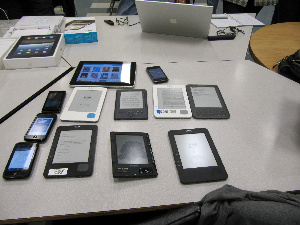Turning Illustrated Books Into eBooks
Nan Barnes
Is an ebook right for you? Ebooks are another alternative for self-publishing authors who want to produce and distribute their book. We have been creating ebooks for a few years now, and they are easier to create than ever. Let's look at how ebooks are produced, who sells them, who buys them, and whether this option will work for you.
 Courtesy of Cloned Milkmen under Creative Commons
Courtesy of Cloned Milkmen under Creative Commons
Much of the positive hype around ebooks is coming from the publishing industry. Publishers love ebooks, as they eliminate the cost of printing and therefore are cheaper to produce. Digital publishing also eliminates the middleman role of retail bookstores.
Many readers have been motivated to buy an ereader device. Why? For the device’s portability, for the convenient digital bookstore, and for the inexpensive book prices, sometimes significantly less than print. This leads some people to believe that producing an ebook is cheap. With a text-only book, this is true, and you can make an ebook yourself. I recommend Smashwords. However, illustrated ebooks, like print books, are much more complicated to design, and they can cost almost as much to create as a print book. The savings is in the printing, not in the design.
Some of the biggest promoters of ebooks go so far as to suggest that all books will eventually be read on a digital device. Yet this trend has already slowed, as readers have discovered the limits of ereader devices. The majority of books that are purchased as ebooks are genre fiction; books that have simple prose formatting.
Nonfiction, technical, and reference books don’t translate as well to the ebook format or sell as well in online bookstores. Print books still dominate in these genres, with buyers expressing a marked preference for the fixed layout of print. As a book designer, there is only so much I can expect to achieve with an illustrated ebook. The design must be crafted to work on all models of ereader, and this means simplifying and deconstructing the print layout to render correctly on every, including early, model of the Kindle.
To understand this, consider the display of a Kindle. The great advantage of a digital reader is its flexibility; as the reader may modify the text font and size. But when they do, other elements move, too. This alters the position of illustrations. Wrapped text, which is used to relate text to an image, is not possible on some Kindle models. Some Kindle models do not support color, either. Much of a book’s design, such as control of spacing and typography, are lost.
Think about how you read a nonfiction book. You use more navigation in nonfiction, often moving in a non-linear way through the book. Print books are spatial; we recognize and navigate sections by their length. In contrast, an ebook doesn’t have fixed page numbers; and an adjustment in font can repaginate the entire book. An ebook’s hyperlinked table of contents will help, but the ability to skip around and orient oneself in the material suffers. It is harder to “use”, and so nonfiction readers often seek the print book over the ebook.
What is the best course? If you are a commercial writer of fiction, especially genres such as mystery, sci-fi, and romance, this platform will make it easier than ever for readers to find and buy your books. The traditional barriers to getting into a bookstore are gone; as the web has unlimited shelf space. The Kindle bookstore handles about 80% of ebook transactions, so you are in the right place.
I believe authors of nonfiction and illustrated books should first offer a print version, and consider an ebook as an add-on if they have many digital readers. Don’t assume that because your readers own a Kindle, that they want to read your book on it.